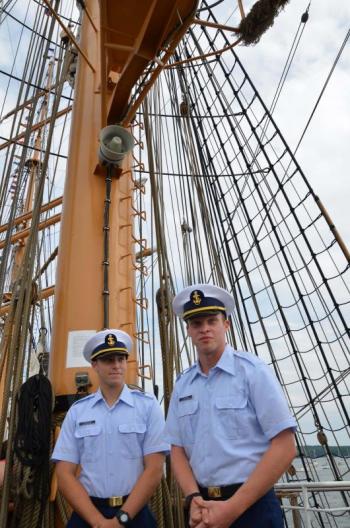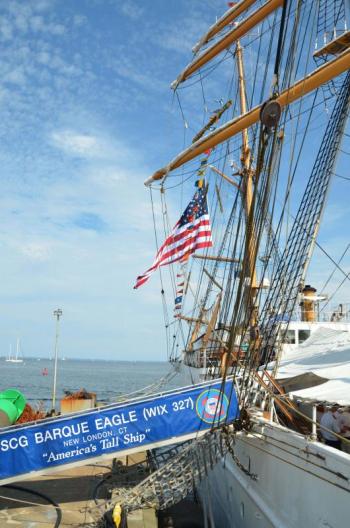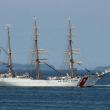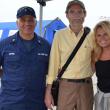ROCKLAND — Boats come and go on Penobscot Bay — sloops, fancy yachts, barges, schooners, container ships — they slip into the harbors and up channels, and people close to the water take note. But when the Coast Guard tall ship Eagle comes to town, everyone sits up, whether or not her large canvas sails are set. Not only a source of national pride, the Eagle represents some of the finest naval architecture and construction that Germany produced in the years just prior to World War II.
The Eagle pulled into Rockland Harbor Friday afternoon, Aug. 1, greeted by a flotilla of local dignitaries. Aboard the 295-foot vessel were 200 Coast Guard Academy cadets, officers and crew, who had sailed downeast on a maritime training cruise, one of several the Eagle makes over the course of year.
“I will never get tired of her magically appearing in our harbor,” said Dorothy Black, a member of Rockland’s Coast Guard City Committee. Rockland is one of 16 Coast Guard cities around the country, designated so by the Coast Guard.
On the wharf at Coast Guard Station Rockland, where the Eagle made berth, the mood was light the entire weekend, as approximately 3,500 visitors filed aboard the vessel on Saturday and Sunday, Aug. 2 and 3, for tours of the largest tall ship sailing under the U.S. flag.
The Eagle is the country’s only square-rigged vessel used in government service and is traditionally tied up in New London, Connecticut, home to the Coast Guard Academy. Over the centuries, this particular Eagle, and the six other Coast Guard Eagles that preceded her, have exposed thousands of American men and women to a maritime legacy that dates back centuries, even millennia. In the seagoing classrooms — on deck, high up in the rigging, or in the engine rooms — the students get a taste of life at sea.
In Rockland, a Coast Guard City, the Eagle and crew were feted over the weekend, first with a recognition ceremony at the Lobster Festival and then more private functions.
It was also a weekend marking the 224th birthday of the Coast Guard, which was created in 1790 when President George Washington signed the Tariff Act, allowing construction of 10 cutters to enforce the country’s fledgling trade laws against smuggling.
The Coast Guard now has 46,000 active duty members, and is both a federal law enforcement agency and a military force; its mission is to enforce the law at sea, protect the marine environment, guard the coasts and ports, and save lives.
The Coast Guard also managed to conduct a massive shift change of cadets during the Sunday tours, a feat that involved the disembarking of more than 100 students, who were loaded, along with their sea bags, onto buses bound for the Coast Guard Academy in New London, Connecticut. As soon as they walked off the vessel and down the plank, another 100-plus cadets, fresh from the New London bootcamp, filed aboard for their three weeks of sea training.
It was also a weekend of spontaneous connections, including the arrival of Julianne Waesche, granddaughter of Russell Randolph Waesche, Commandant of the Coast Guard, 1936 to 1945, and who was responsible for the acquisition of the Eagle from the German government as part of war reparations.
Waesche just happened into Rockland the same weekend as the Eagle’s visit purely by coincidence. Under her 30-pound backback, this former real estate agent was on a walkabout of the United States, exploring the country on no particular timetable and with no firm destination in mind.
“I fell into Rockland,” said the Washington, D.C., resident, who lives on a 45-foot houseboat.
Russell Waesche was also responsible for creating the Coast Guard reserves and who is known for presiding “over the greatest expansion of the USCG in its history and made sure the service maintained its separate identity while it was under the administrative control of the U.S. Navy,” according to the Coast Guard’s history page. “Admiral Waesche saw his small peacetime fleet swell with Coast Guardsmen manning more than 750 cutters, 3,500 miscellaneous smaller craft, 290 Navy vessels, and 255 Army vessels.... In 1943 Waesche also secured Congressional support for the Coast Guard’s return to the control of the Treasury Department as quickly as possible after the end of the Second World War. In doing this, the service avoided the problems that occurred after the end of the First World War when the Navy attempted to maintain its control of the Coast Guard.”
Julianne Waesche fell into conversation with Coast Guard Maritime Enforcement Chief Michael Lafond, of Rhode Island, and Chief Warrant Officer Kristina Arsenault, of Arlington, Virginia, both of whom were stationed temporarily in Rockland with Eagle’s visit. The three of them delved into Coast Guard history and their own reasons for joining the smallest, yet most versatile division of the armed forces.
Lafond, who had been in the Marine Corps, joined the Coast Guard after college.
Eagle history
The U.S. Coast Guard acquired the Eagle from Germany in 1946, as a war reparation.
The vessel’s strong steel hull was built for seamanship training 77 years ago at the Blohm & Voss yard in Hamburg, Germany, commissioned by Hitler. A U.S. and German crew sailed it through a hurricane and into New York Harbor that year. Built for training military sailors, that heritage comes alive every time its square sails are hoisted over the 147-foot masts.
The vessel was built in 1936 as training ship for young Germans and for 10 years, and was originally named the Horst Wessel after one of Hitler’s lieutenants, who was killed violently in the dark of night.
The Eagle has four sister ships, three of them apportioned to other countries following WWII. Mircea is owned by Romania; Sagres II, Portugal; Gorch Fock I, Germany (this ship returned to Germany after being owned by Russia, but then in need of repairs, was privately funded to go home). In the interim, Germany had built another Gorch Fock II in 1958, based on the original Gorch Fock I design. The last time they sailed together was in 1976 during the U.S. Bicentennial, in New York Harbor.
“Just put me in the uniform,” said this chief, who can rattle off a wealth of military history he has retained in his mind.
Arsenault has a similar affinity for the Coast Guard.
She grew up on Block Island in the 1980s, “running up trees and racing my best friend down to the breakwater to watch the Coast Guard medevacs transport the sick and injured to mainland hospitals.
She told her friend, “some day I’m going to be in the Coast Guard.”
Over the course of her Coast Guard career so far, she has been stationed in ports around the country (Hawaii, San Francisco, Baltimore, Seattle), has boarded foreign freight vessels flying under all kinds of flags, and testified in federal court against shipping companies that have polluted American waters.
Of the 256-member Class of 2018, 33 percent are from underrepresented minority groups and 36 percent are female. The incoming class represents 48 states, the highest number of states in at least 20 years.
Onboard the Eagle, the newest Coast Guard arrivals were getting their sealegs and having just stepped off the bus and into uniform, were pressed into action as tour guides. Their knowledge of the vessel was classroom-learned, but they were handling it as the line of tourists snaked around the foredeck and down along the waist.
Kurt Kominske, of Sayreville, Long Island, and Jonathan Behnke, of Carlisle, Pennsylvania, had graduated high school in June, and now they were immersed in Coast Guard studies. They had just finished a course about Coast Guard Heroes. Whom did they choose to research?
Fresh out of boot camp in 1980, Seaman William Ray Flores was assigned to the cutter Blackthorn in Texas. On Jan. 28, 1980, the Blackthorn and tanker collided near Tampa Bay, Florida.
“After the ships collided, Flores and another crew member threw lifejackets to their shipmates who had jumped into the water,” according to the Coast Guard. “Later, when his companion abandoned ship as the Blackthorn began to submerge, Flores, who was less than a year out of boot camp, remained behind and used his own belt to strap open the lifejacket locker door, allowing additional lifejackets to float to the surface. Even after most crew members abandoned ship, the 18-year-old Flores remained aboard to assist trapped shipmates and to comfort those who were injured and disoriented.”
Flores perished while saving his shipmates, and in 2000 was posthumously awarded the Coast Guard Medal, the service’s highest award for heroism not involving combat.
“He was as young as we are,” said Behnke.
He said he joined the Coast Guard because he has always loved being out at sea, and wants to work on humanitarian missions to save lives.
Caminske said he wants to work in drug interdiction, especially after watching his hometown suffer from the influx of heroin.
Also onboard the Eagle in Rockland was the Coast Guard’s first-ever female superintendent of the Coast Guard Academy, Admiral Sandra Leigh Stosz.
“I proudly watch as the cadets go into the restaurants and walk the streets,” said Black. “We welcome all Coast Guard into our city. Most of all we are very proud of ‘our’ Coast Guard. If you see them around town thank them for their service and being in our city.”
The Coast Guard is equally affectionate of Rockland.
In September 2013, Penobscot Bay Pilot spent a week aboard the Eagle with the Coast Guard’s officer training sail from New London, Conn., to Portsmouth, Virginia.
On the fore, on the main, on the mizzen! Sailing aboard Coast Guard tall ship Eagle
Photo gallery: A week aboard the U.S. Coast Guard tall ship Eagle
“The Eagle is a tremendously significant ship to the Coast Guard,” said Arsenault, in an official statement from the Coast Guard. “It is a symbol of maritime legacy in a modern era. The fact that brand new cadets have the opportunity to train on a platform like the Eagle, and that a Coast Guard City such as Rockland is always graciously willing to host us, makes the experience of fusing the old with the new that much more relevant. Rockland is a special port and it maintains its nautical traditions in the purest form. To have the Eagle add to that legacy is always an honor.”
The Eagle departed Rockland Harbor Aug. 4, heading back down to the coast toward Connecticut.
After a September training cruise with officer candidates, the Eagle will head to drydock in Baltimore, the second year of a staggered five-year overhaul, during which 220 independent items are to be repaired and retrofitted.
Next spring, the Eagle will be “splashed” again, back in the water for another season of service to the country.
Editorial Director Lynda Clancy can be reached at lyndaclancy@penbaypilot.com; 207-706-6657

































